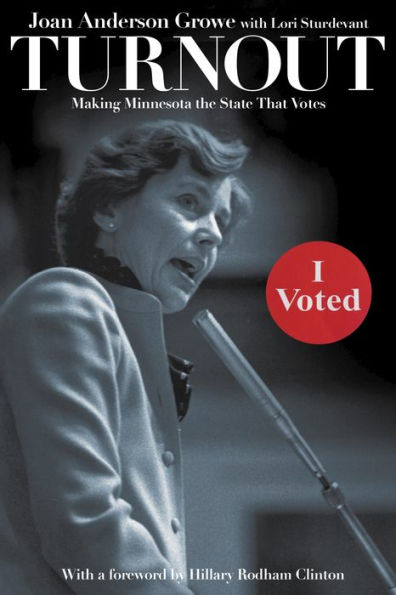
Turnout: Making Minnesota the State That Votes
224
Turnout: Making Minnesota the State That Votes
224Paperback
-
PICK UP IN STORECheck Availability at Nearby Stores
Available within 2 business hours
Related collections and offers
Overview
In inspiring and often funny prose, Growe recounts the events that framed her life and changed the state's voting practices. She grew up in a household that never missed an election. After an astounding grassroots feminist campaign, she was elected to the state legislature in 1972; two years later, she was elected secretary of state, the state';s chief elections administrator. As one of the nation's leading advocates for reliable elections and convenient voting, Growe worked with county officials to secure Election Day registration (used for the first time in 1974) as a Minnesota norm. She brought new technology into elections administration and promoted "motor voter" registration. And as an ardent feminist, she has encouraged and inspired scores of other women to run for office.
Part political history and part memoir, this book is a reminder to Minnesotans to cherish and protect their tradition of clean, open elections.

Product Details
| ISBN-13: | 9781681341637 |
|---|---|
| Publisher: | Minnesota Historical Society Press |
| Publication date: | 08/11/2020 |
| Pages: | 224 |
| Sales rank: | 1,143,604 |
| Product dimensions: | 5.80(w) x 8.90(h) x 0.80(d) |
About the Author
Lori Sturdevant, a retired Star Tribune editorial writer, is the author of several books of Minnesota history, including Her Honor: Rosalie Wahl and the Minnesota Women’s Movement.
Read an Excerpt
Something small that Joe [Mansky, elections procedures advisor] spotted during his first election season in 1984 became significant later. A state House race in New Hope, a Minneapolis suburb, was won by DFLer Ann Rest over Independent-Republican Rep. Dorothy Hokr by only sixty votes. Any federal, state, or legislative race decided by a margin of less than 0.5 percentage point qualifies for an automatic recount under Minnesota law. Joe was dispatched to New Hope to preside over the recount process, and in so doing, he noticed that the punch card ballot pages that the district used were designed in a confusing manner. It would be easy for a voter to punch the wrong hole without realizing his or her error. These were butterfly ballots, which became notorious in Florida in the hotly contested 2000 presidential election. He also saw that when punch card ballots were handled multiple times, as they are in a recount, perforated paper bits or “chads” can be inadvertently dislodged from the cards. That leaves the appearance that the voter cast votes for more than one candidate, thus spoiling the ballot for recount purposes.
When Joe reported his concerns to me, I took several steps to remedy the situation. First I decided to stop certifying new punch card voting equipment for use in state elections. We were the first state in the country to do so. That didn’t end their use immediately. But it meant that as equipment became outdated and needed to be replaced, punch cards would be phased out. In 1990, punch card voting was still in use in 18 percent of the state’s precincts. The last use of a punch card system in Minnesota was in the city of Biwabik in 1994. All were gone well before “hanging chads” became household words in 2000.
Second, I also decided to ask the legislature to prohibit the use of any new voting system in Minnesota that lacked a paper ballot, such as the then-emerging touch screen voting systems. Again, we were the first in the nation to take that step. Third, I instructed Joe to revise the administrative rules for use of the punch card system to eliminate the butterfly ballot format from further use in Minnesota elections. Butterfly ballots flew away in Minnesota fifteen years before the Bush v. Gore controversy in Florida.
Punch cards were still in use in 1986 when what Joe calls his craziest election crisis occurred. A big thunderstorm socked Rice County, south of the Twin Cities, not long after the polls closed on primary election day that year. County officials had packed the ballots in an unsealed metal box and hauled them in an open-box pickup truck to the courthouse, where they were to be tabulated by the county’s computer. When the box was opened, officials found that several hundred punched ballots were wet and would potentially jam the computer. They called Joe.
“Put the wet cards in the microwave to dry them,” he recommended, not at all sure the trick would work. It did, and Joe’s reputation as an elections wizard grew.
Securing the accuracy not only of the initial count, but also of any subsequent recount, was a high priority in our office. Close elections that trigger automatic recounts are not uncommon in Minnesota. The state has seen 88 of them in legislative races since 1849. It has the distinction of being home to the closest gubernatorial election in U.S. history, DFLer Karl Rolvaag’s defeat of Republican Gov. Elmer L. Andersen by 91 votes in 1962. More recently, US Sen. Al Franken defeated US Sen. Norm Coleman by 312 votes in 2008, in a contest that featured the largest recount in U.S. history. Both of those squeaker elections led to months of recounting and litigation. Through much of its history, Minnesota has been well served by two vigorous parties that compete on a fairly even basis in large portions of the state. Gerrymandering for the sake of maximizing the number of “safe” seats for the two parties has been rare.
Table of Contents
Introduction 1: Rooted in Democracy2: What’s a Government For?
3: Riding the Second Wave
4: Open Government
5: Chief Elections Officer
6: Traveling Secretary
7: Running “As a Woman”
8: Turnout
9: The Nation’s Leader
10: Sustaining the State That Votes
